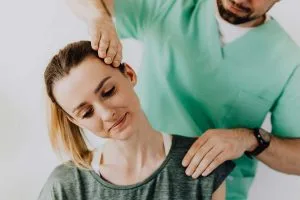Shoulder Joint Replacement
Joint replacement provides individuals that experience joint pain with an opportunity to rid themselves of their injured or arthritic tissue and move forward to a life of an improved range of motion and pain-free exercise and movement. While a shoulder joint replacement or a Total Shoulder Arthroplasty (TSA) is not as common as a knee or hip replacement, its ability to restore function to a previously injured joint is distinct. In most cases, arthritis to the shoulder joint results in painful grinding and grating when the joint moves. At a certain point, NSAIDs, injectable steroids, and other methods lose their efficacy, and surgery may now be the only option. The medical professional team caring for you during your journey towards shoulder joint replacement will provide all of the support a patient needs before and after the surgery.
After the medical professional team conducts the necessary imaging and diagnostic tests, they may determine that surgery is their patient’s only option for a complete recovery and pain-free lifestyle. When they inspect their patient’s individual circumstances, they must also decide whether they might benefit from a standard Total Shoulder Arthroplasty or a Reverse Total Shoulder Arthroplasty. The choice between these surgeries can mean the difference in certain rehabilitative protocols. A skilled physical therapist must work closely with their patient’s surgeon and primary physician before implementing a rehabilitative plan.
Causes for Surgery
Some of the causes for surgery can include:
Osteoarthritis
Damage and wear on the cartilage in the joint result in bone-on-bone contact. This results in pain and lack of movement in the shoulder. Osteoarthritis is irreversible, and so surgery is a common option.
Severe Fractures
The head of the humerus can fracture in some traumatic injuries and in patients that have osteoporosis. In this circumstance, reattaching fractured bone is not always successful. The surgeon may suggest a replacement in this situation.
Avascular Necrosis
In cases where an injury interrupts the blood supply to the head of the humerus, the bone cells begin to die and move towards joint damage and eventually, arthritis. Previous injury to the joint and certain behaviors such as steroid use can increase one’s risk of developing avascular necrosis. Irreversible bone death dramatically increases the likelihood of a replacement.
Learn more about the risk factors that predispose someone for TSA.
Anatomy
The shoulder is a ball-and-socket joint that operates in multiple planes of movement. Because of this, it is susceptible to injuries concerning the head of the humerus (ball) and the labrum (socket). In a healthy shoulder joint, there are three bones, several major muscle groups, and the tendons and ligaments that connect and support these constituents. The bones are the humerus (long, upper arm bone), the scapula (shoulder blade), and the clavicle (collarbone). The main muscles of concern in a TSA are the rotator cuff muscles. These muscles can mean the difference in the decision between a total or reverse TSA.
In the diseased shoulder joint, the cartilage between the ball and socket deteriorate, disturbing integrity, movement, and comfort. The surface does not regenerate more fluid into the joint, nor does it regrow any lost cartilage, and therefore the individual no longer has a healthy glide in their shoulder. In some cases, there may be a partial or complete loss of the rotator cuff muscles, causing more incomplete stability along with the pain. In this circumstance, a physician and surgeon may recommend a reverse TSA.
Total vs. Reverse TSA
Total TSA
In the standard TSA, a prosthesis “ball” made of metal replaces the head of the humerus. The plastic socket then fits around the metal component, successfully mimicking the joint’s natural movement. These components are sometimes cemented, and can even contain parts that allow for natural bone growth to occur inside them.
Reverse
Patients with damage to their rotator cuff muscles or tendon qualify for a reverse TSA. This affects the placement of the new, artificial ball and socket. The metal ball now goes in the shoulder where the cartilage would normally sit, and the socket in which the ball moves is implanted into the head of the humerus (upper arm). By doing this, the deltoid muscles of the shoulder can do the work of the damaged rotator cuff components.
Check out this video to see a patient’s first-hand experience with a reverse TSA.
Rehabilitation: Differences Between Replacements
Rehab considerations between the two types of replacements are similar with one notable exception. In a standard TSA, the subscapularis tendon (located on the long arm bone) is often detached from the humerus and then reattached. Because of this, extra time and precaution are given in order to permit and perform external rotation movement of the shoulder. Functionally, external rotation is a movement that dictates many of an individual’s daily habits such as reaching behind your head to wash your hair, reaching for a seat belt, and participating in throwing sports.
The standard TSA and reverse TSA will require the patient to use and wear a sling for at least a 3-6 week period. Therapy will initially consist of passive movements performed by the therapist with eventual active-assist movements. As the patient progresses onto the active-assist, they may utilize tools such as pulleys, canes, and their good arm to support the movement of the post-operative shoulder.
During physical therapy, the therapist will provide ice and electrical stimulation for any pain and swelling incurred after the surgery. Stretching exercises do not usually begin until about 7 or 8 weeks after the surgery, which the therapist will permit following the surgeon and primary doctor’s collaboration. In most cases, the total rehabilitative process in physical therapy can last approximately 12 weeks.
Rehabilitative information provided by our head Physical Therapist, Charlie Mills.


